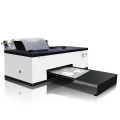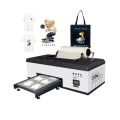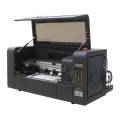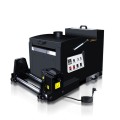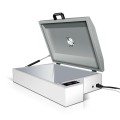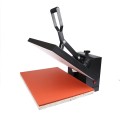Why this DTF printing replaces DTG printing?

Offset printing is a traditional type of lithographic printing. In simple terms, offset printing is a printing method that transfers the graphics on the printing plate to the substrate by means of rubber rollers.
Over many years, offset have been developed to digital offset printing, widely used in publications(paper, books), packaging industries.
Recently, a new type of offset printing has come in the textile market, specifically in the clothing market. It has similarities of Direct To Garment printing, but removes some drawbacks. As it uses a film to transfer, we call it Direct To Film or Digital Transfer Film.
HERE’S ALL YOU HAVE TO PREPARE BEFORE PRINTING,
- a Printer (with Epson printhead, or Industrial printhead), with special ink
- a Powder Shaker (Not a must-have thing, but it saves much time)
- a Heatpress
- a roll of PET film
- some special powder
- finally, your any substrate, like a nice 100% cotton T-shirt, or a canvas bag.
HOW IT WORKS,
- choose a very fancy image and print it on the PET film, with the printer. Just like what you do with DTG. Don’t forget to choose the mode “Mirror Image”
- Next, the PET film with image goes into the Powder Shaker. Inside, the film will be applied with some small amount of powder, then the Shaker will shake and remove extra powder, finally the Shaker will dry up the powder on the PET film.
- Set your Heatpress with 150 celcius, 18 seconds. Pess the PET image onto your substates.
Job done!
SO, WHAT ARE THE ADVANTAGES AND DIFFERENCES THAN DTG?
Digital offset from PET film
1. Transfers on anything! Onto flat surface, curved surface. Not only just clothes.
2. Pretrement not needed.
3.Short pressing time, lower temperature. Usually 150 celcius, 18s~25s.
4.Shorter production time, because you can print on PET first, you can stock up PET films.
SO, WHAT ARE THE ADVANTAGES AND DIFFERENCES THAN DTG?
DTF, transfer from film
1. Transfers onto anything! Onto flat surface, curved surface. Not only just clothes.
2. Pretrement not needed.
3.Short pressing time, lower temperature. Usually 150 celcius, 18s~25s.
4.Shorter production time, because you can print on PET first, you can stock up PET films. 1 heatpress can produce up to 5 clothes.
5.Simple production, as long as you have set up images, printer can print on PET continuously.
more to imagine…
DTG Printing (SC-F2000 as an example)
1. Only cotton or cotton blends. Flat surface only
2.Need pretreatment on black or dark clothes.
3.Pressing time and temperature varies, mostly 180 celcius, 30s~90s.
4.If you are handy, usually 1 T-shirt need 1 mintute to finish.
5.DTG printing process only allows 1-2 person to work on 1 printer at a same time. If you want faster production, you need more printer and heatpress.
COST,
Generally, the equipment cost, the using cost and the maintenance cost wouldn’t higher than using DTG printer.
The more you print, the cheaper the cost, especially the scale effect of DTF has.

